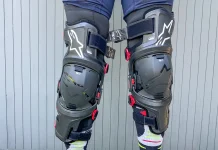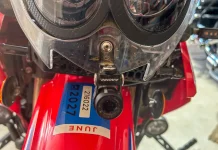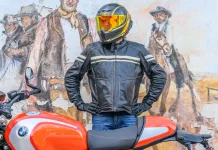Hot Grips Heated Grips Test
Numb fingers equal less riding time – this is one proven equation for an East Coast winter motorcyclist.
Whether bulky or thin, winter gloves help, but eventually the cold creeps in, especially at sustained highway speeds. Then there’s heated gloves. Yep, they work, but they also require uncomfortable wiring, and extreme warmth when only a bit is needed on a cool evening.
The only other possibility? Heated grips. They make sense, especially when you can control the heat, and are the perfect solution to the numb fingers equation mentioned above.
So heated grips were added to my list of accessories for my Suzuki V-Strom DL1000 build in my attempt to make the bike more capable for true adventure riding throughout 12 months here in Northeast Pennsylvania.
Research began, and I came across the story of Jim Hollander, the founder and owner of the New Hampshire-based Hot Grips.
A former ISDT rider, Hollander began working on heated grips back in 1976. And while studying Mechanical Engineering in 1980 at UMass, Hollander developed the first production-heated grip. This all led to the creation of Hot Grips – a simple name for an innovative product. With such a history, Hot Grips were the product I decided to use for my V-Strom build.
I also opted for the Variable Heat Controller, which features a knob that you mount directly to the bike’s upper panels. In my V-Strom’s case, I mounted it to the upper left panel, keeping it out of the way but easily accessible with the non-throttle hand. The controller is a simple knob that increases the grip’s heat by turning clockwise. When turned completely in the counter-clockwise direction, it clicks into the off position.
Hot Grips Installation:
Installation was simple. The 2002 V-Strom arrived with optional factory heated grips, and after 10 years of use they were shot. But I simply used the positive and negative wires from the factory heated grips main wiring harness to wire the Hot Grips.
The Hot Grips arrive with two long wires on each grip. Connect one wire from each grip to each other. The remaining wires from each grip are also connected to each other, and then wired to the black (negative) wire on the Variable Heat Controller. Those three wires get grounded; in my case, I used the ground wire from the stock heated grip setup.
The remaining red (positive) wire from the Variable Heat Controller is connected to a power source on the V-Strom, and in my case I used the power source from the factory-heated grips.
Hot Grips also has an installation section on its website that explains how others have installed the grips on various models, both with and without the use of the Variable Control Unit. Also, the Hot Grips staff will answer any questions pertaining to the installation of the grips.
Installation is a straightforward process. The Hot Grips require glue, and, if you need to use a new throttle tube as I did, a bit of modification. The clutch side is simple – remove the bar-end weight and old grip, use half of the included two-part epoxy specifically designed for plastic use, and install the Hot Grip. Superglue is not recommended due to heat the grips give off.
Because my throttle tube was old and frail, I decided to opt for a new one. The replacement OEM part, though, had an extended ring on the outer part of the tube that I had to cut off (Dremel tool with cutting wheel). After that, everything else was simple –use the other half of the mixed Epoxy, and install the grip.
The Hot Grips feature a grooved-design. When sliding the grips on, the epoxy fills these grooves, allowing for a clean installation. Sure, a bit will push out on the inner edge of the grips as you push them on, but simply use a wet rag to wipe off the excess.
I also installed the grips with the wires at the 6 o’clock position on the clutch side, and closer to the 7 o’clock position on the throttle side. This provides a clean look, and, on the right side, doesn’t allow the wire to interfere with the throttle. Makes sure to check this before allowing the epoxy to set.
The most laborious part of the installation was running the wires. Make sure to double check for binding with the handlebars all the way turned, especially on an adventure or dual-sport motorcycle. And again, make sure the wire on the throttle grip does not interfere with the throttle function before allowing the epoxy to set.
One note on the variable heat-control unit. After I installed mine, I turned it and it kept turning clockwise. This was a highly unusual circumstance, and when I emailed the folks at Hot Grips, owner Hollander responded within the hour. There must have been a defect with my unit. Nonetheless, he sent me a new control unit, and it performed flawlessly. The folks at Hot Grips also used the defected unit for study, helping to increase the construction of future designs.
Hot Grips are exactly that, Hot
I let the epoxy set for about 20 hours, and the following November day, I was on my first ride with the Hot Grips. The Hot Grips feature a bit larger diameter than the V-Strom’s stock units. I was initially worried about the larger design affected feel, especially while in the standing position while off-road. But it took only a few miles to get used to the slightly larger diameter, and the design didn’t hinder my off-road performance.
The temps were around 40 degrees, and I quickly learned the advantage of the variable heat control unit. While wearing Weise Manx gloves in these temps, I only had to crank the heat to about 50 percent – anymore and my hands began sweating.
Since then, I’ve used the Hot Grips while riding in the early morning when temps were in the low teens, and my fingers and hands remained warm. Before the Hot Grips were installed, I used a bulky winter glove when the temps dipped into the teens, such as Held Freezer gloves. But since using the Hot Grips, the bulkier winter gloves have remained stored away; mid-weight gloves such as the Weise Manx are more than sufficient in the teens with the Hot Grips.
I’ve also used the Hot Grips on days in the 60s when heading through mountain passes. In the past, I would pull over and switch to a warmer glove, and when things got warmer, switch back to the lighter gloves. With the Hot Grips, I just turn a knob to the desired temp. This same scenario also makes riding on cooler nights much more comfortable.
And that’s what the Hot Grips ultimately help a motorcyclist achieve – personalized comfort. Nothing can kill a ride more than stopping due to cold hands, which are always the first to get chilly. With the use of Hot Grips, especially with the variable heat-control unit that is a must have, riding becomes much more comfortable, a need for an East Coast motorcyclist such as myself who rides all 12 months.
Regarding durability, I’ve only used the Hot Grips for around 5000 miles to date in both rain and a bit of snow, and they worked flawlessly, showing no signs of wear. I’ve read and witnessed pictures of riders getting 100,000 miles or more with Hot Grips, so they are more than durable. And I plan on adding many more miles to the around 70K already on my Strom, so if you’re reading this years later, get in touch.
The Hot Grips arrive in 7/8” and 1” applications, which are available in various lengths, allowing them to fit various models. They retail for around $120, and an additional $41.95 for the Variable Heat Controller, which is a must for the rider who wants personalized comfort.
For additional information, log onto hotgrips.com.
For other stories on Ultimate MotorCycling’s V-Strom build, check out the following:
V-Strom Touratech Zega Pros Review









